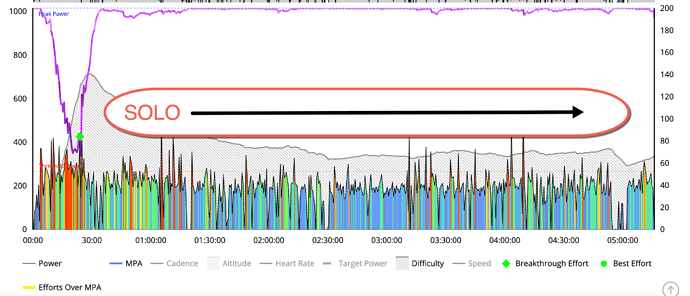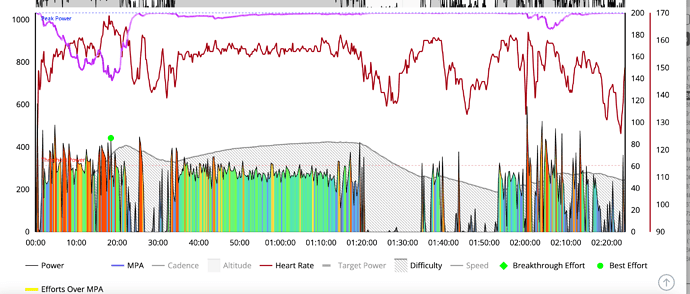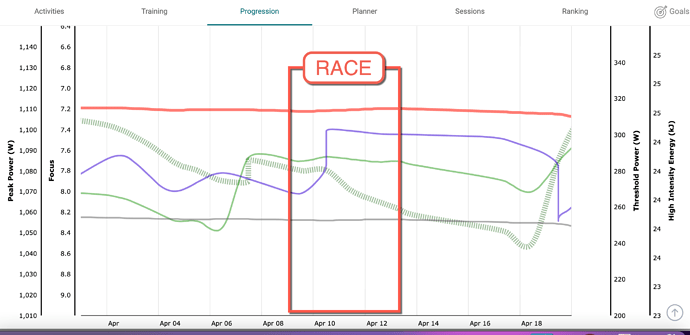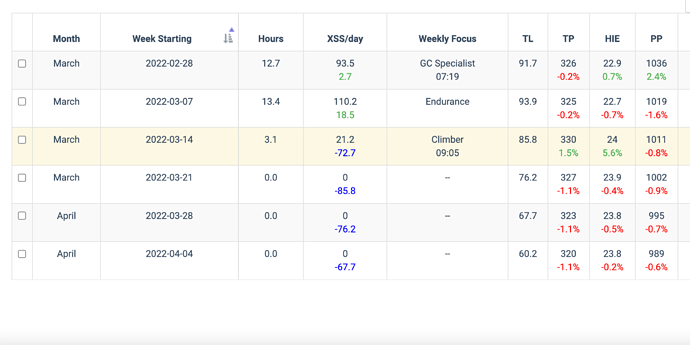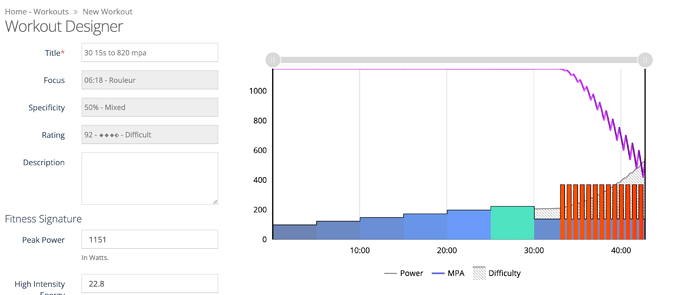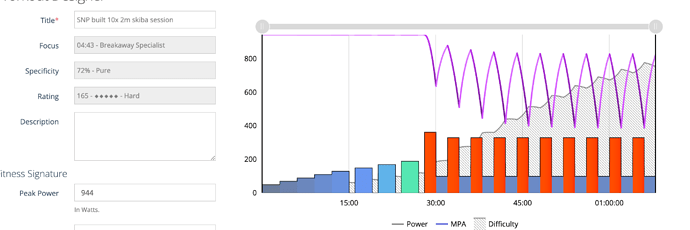I have been using Xert now for about a year and am really impressed. I remember many podcasts ago hearing an interview with the Xert guys. I think it would be great to revisit that platform, hear about their improvements and future plans, and what they have learned as they grow the user base. Super cool platform. I’d love to hear from them again.
Since Fast Talk is basically agnostic to training platforms it might be interesting if they did a podcast on the future of training platforms such as Xert, TR, AI Endurance and many others out there. Each has some interesting aspects, none are perfect.
I’m new to exrt, about 3 months, after 2 years of canned workouts, it’s a lot to digest but feel the metrics that contribute to xata’s adaptive nature are ahead of other platforms. The support and community are very helpful. I follow HRV and occasionally adjust workouts, that integration could occasionally help, spot trends before I feel them.
Hi @TomCaldwell, on the Xert forum we have discussed to use of HRV as well. I thnk there is some movement to look in that direction, but then again we have the sort of info that Marco Altini is noting that HRV and DFA a1 do not react the same for all. I do use morning HRV to adjust my workout goals in reaction to the likihood that I need to take it easy. Xert is a lot to take in and it does take some dedication to wrap your head around… Which is one reason I think a platform like Fast Talk is a great way to discuss the options of this vs other adaptive approaches to self coach/ self selection of workout planning. Another planning platform I have been trying this year is AI Endurance where they are very into HRV and DFA a1. Markus (the programmer and owner) is doing some interesting things on that one for presenting an AI approach to workout planning and prediction. I think things are really moving fast in the direction of more machine learning approaches to how we train.
Thanks for the reply Scooter,
I’ve dabbled in other walks of life with process control, using AI, that had mediocre results. That said I believe it is having good results in the medical arena, so expecting likewise in fitness.
I think xert’s multiple data calculations in the end aren’t far off a “analog” AI of sorts. Once the fitness signature is dialed in and occasionally challenged, it works well. Through videos, blog and support they are getting us inside the black box.
AI endurance looks interesting, some choices to make but with AI the black box pretty much stays shut. I’m surprised after downloading Strava access that that ftp tests are still needed.
Have you compared the results of both, from a aspect of meeting projections and time requirements? Also looks like AI schedules rest days in, do you find one platform more intuitive to acknowledging fatigue?
Thanks,
Tom
I think AI is still a work in progress. HE is working diligently on updates etc but as with any machine learning program, at some point the algorithm takes over and the ability to look inside and see what is going on is likely to be lost. I agree that Xert is an analog sort of system. I believe it is simply a model that works on 2 variables which is the interesting point. I use complex mathematical models which I have no understanding of the real math underlying the process. Principal components analysis, multiple linear regressions etc… and I still have a hard time conceptualizing orthogonality in multiple dimensions past 3…
I think the big question is do I fit the model or am I an edge case? For Xert it seems to be pretty good for me. AI Endurance the jury is still out.
What is it that everyone would like to revisit?
I have a pretty solid xert background and have even tested Armando, on my met cart.
I have 9 private clients all using the software, some for over 5 years.
What is it that you are looking to revisit?
I’ve been using XERT for 6-7 years now I guess and currently only use it to go for breakthroughs on VO2 climbing outside and during endurance rides trying to keep power in blue and fat gauge in red and at the biggest number I can achieve without losing the ‘blue’ power (i.e power below LT1). I do use the workouts and the XERT player on the trainer especially the LT1 workouts and have adapted some of the VO2 workouts to use outside by creating the workouts in Trainingpeaks using the power and duration levels form XERT, and using the lap button feature to ‘start’ any intervals once I get to a hill/convenient place during the ride to execute the interval. I’ve not really used XATA fully but will look at the recommendations to see what sort of focus a ride should be. I really like the platform, but understand that I am only using a small proportion of its potential. The generation of TP metric is good for me as being a 58 mountain biker I am now excluded from doing tests in my local Sports Science university lab as I’m now considered too old! Makes me laugh when I pass ‘younger’ riders out on the trails
Useful things would be how do you use/how much emphasis you put on the different metrics LT1/TP/HIE and how accurate do you think they are? Also how best to use of the various Garmin XERT apps such as Fat:Carbs, TTE and XSS and XEP on both the trainer and free riding outside - I think I have a handle on the MPA/Power field. I’d also like to know how useful you think using XERT is in planning a season and how you use it in conjunction with other platforms. Also an important thing would be how NOT to use XERT. I have also recently asked to use you as a coach in XERT - not sure what that means other than I presumably get access to any workouts you have created and posted in the workout library.
I think it is in my opinion not just revisit Xert, but maybe other platforms that are less known? One aspect of Xert that is something they have to get to grips with as a company is that it is not straight forward to use and understand. I would suggest a deeper dive sort of review to come to a better understanding of how it can be used? then maybe looking more broadly at other training platforms?
I am really involved in the forum and not the podcast of FTL, so I will put a few examples of how I use XERT.
1 - I use the planner often to show how effective aerobic can be on a persons long term progression
2 - I use it to give confidence in an athlete who has had trouble at a certain part of a race in the past. The example below is a race last year, where the athlete got dropped out of the top 20 (they were forced into groups of 20 due to covid), and then had to solo remainder.
Actual Race in 2021 - race day signature - the group he started in finished together and the winners were in this group.
1015w - 21.8 - 266w
Same race with now current signature, heading into the race this weekend with some good confidence. If the race is similar, which it often is at the front of this race, then staying in the group should be very different and lots more room to see how things go. He should be able to be in the mix.
1150w - 22.8 - 282w
+++
Another example of the same thing is in a mountain bike race.
2 years ago last time this race was held.
1084w 24 313w
Same stage as above with current 2022 signature.
1018w 24.1 332w
So with the current level of fitness, there is much more room again, so the athlete will be able to climb stronger, and have a faster time. In 2019 he did win the race by over 8m a day, so quite a lead over the previous year’s winner. In 2022 will be racing down an age category as well as trying to improve on his top ten overall placing in 2019.
+++
3 - looking at focus duration of actual events
I also like to look at the focus duration during good results of an event. This helps me take someone trying to win a certain type of event that I get them in the right domain, or help someone else racing an event of a similar type for the first time what the event might be like by planning rides with that focus duration. Keep in mind that you can game focus duration, so I always try and have a similar type of ride to create this focus when doing race simulation training.
So the stage race below has a focus of around 7-8m.
So using this to confirm training that is planned is heading in the right direction is also a useful time.
+++
4 - Use the workout builder to create workouts to work on limiters or race situations an athlete is challenged by.
Also try and create workouts that are what I am looking for. Near breakthrough early? Breakthrough at end? Near breakthrough at end?
Below is example of using 30/15s to take MPA down to a certain level that has been challenging the athlete some recent races, with not enough racing based on where he lives, need to try and mimic race sims as close as possible.
So the session is built to bring the athlete to a goal MPA in a certain amount of time.
I mix this up with building sessions by XSSR so that the athlete can do the intervals more naturally (like hard start) but have a carrot to chase.
Not a podcast but just some of the ways I use XERT.
LTP for one of the athletes above is around 270w, but I know his measured fat max is 230w, so although LTP works for some, it doesn’t work for all. Other than that I have found the other metrics work extremely well.
Forgot to mention, I don’t really have many workouts built in my library and some aren’t even finished.
I do build them in my clients libraries when needed.
I can accept you but there isn’t too much exciting there for you sadly!
Thanks @steveneal. The focus field is not one I’ve used at all so I will pay more attention to it. I’ve noticed it drops rapidly with intensity and then drifts more slowly back upwards.
@steveneal @mastracci - as someone who’s considering a high intensity block I’d be interested in your views on the accuracy of Xert’s modeling of HEI fatigue. My understanding is if your stars are yellow, you should be doing endurance work, but once the change back to blue you can do another HEI session.
- Is this modeling unique to each individual?
- Is there a potential benefit to blocking high intensity workouts, i.e., ignoring Xert’s advice, for short periods of time?
Thanks!
-
It is based on your own individual training and recovery loads for each system. So in that sense it is unique to each individual. If for some reason you don’t exhibit the same freshness as what the system determines, you can use the Freshness Feedback slider to adjust. This is superior to changing time constants for example. Changing time constants for the XPMC is not advised since increasing or decreasing a time constant affects both its duration but also the amplitude of the impact.
-
From Xert’s perspective, the benefit is to increase your overall training loads based on available time and to then return to freshness when time is more limited and/or tapering for an event. In the current model, you don’t see an acceleration of gains by doing intensity when your status is yellow for example. This isn’t to say there are no additional gains only that Xert doesn’t model them.
Thank you! To clarify point #2: you are saying the model doesn’t assign additional weight to high intensity work done while that system is (modeled to be) already fatigued. Correct?
That is correct and why the system advises you to do easier endurance during recovery.
@fazel1010 I will let @mastracci andle the tech questions he is the man!
Here is one of your sessions you built out that I tried to build out in xert.
Power approx 50% available (between mpa and power, then the rest of the intervals similar, no breakthrough)
I am a long term user of Xert and the focus field, IMHO, is the hardest part to understand.
I rely on the TP from Xert for my FTP setting above that from any other system. They are often quite similar but Xert is the one source that I use as my baseline.
This is a post that I entered into the Xert forum but came across this one as well so thought it may be worth posting. Apologies to those who have seen it twice…
@steveneal apologies if I have your philosophy wrong!
The more I read about training and racing it seems that the systems that need to be trained boils down to PCr, anaerobic (glycolytic) and aerobic. The balance of training will depend on the demands of your disciple. If the glycolytic system increases in strength (HIE) the TP/LT1 will fall. The classic table in training and racing with a power meter relates training zones to adaptions (central and peripheral) and Tom Bell @ High North Performance (The Physiological Demands Of Cycling Disciplines — High North Performance) has published this useful table regarding the demands of events. It would seem that you need to balance training and adaptions that occur to the demands of your event.
There are different philosophies as to how this may be achieved. Some I am familiar with include:
- Balance VLamax and Fatmax (Sebastian Weber @ INSCYD) the argument here centres on peripheral adaptions that include increased mitochondrial density and more importantly converting intermediate fibres to slow twitch
- Tim Cusick/Fasttalk/Coggan extensive to intensive (classic periodisation model). I think the Xert model seems to adopt this with progressive transition from extensive to intensive interval; the approach of other is a little more stepwise. Zone 2 training forms the basis with volume increasing in the base phase through the build phase (intervals focus on longer durations sweet spot/tempo/threshold). Toward the end of the build phase move towards more specific race intervals, reducing volume but raising intensity. Perhaps moving from more of a pyramidal distribution to polar (on the basis that recreational athletes do not have the sky high LT1 of pros).
- Steve Neal raising LT1 through extensive tempo work (but strict definition of tempo zone) this then raises LT2 with it. VO2 max work once no longer seeing an increase to raise the ceiling. To me there are similarities in this approach to the Inscyd approach (Tom Bell again [How To: Fine-Tune Your Max Glycolytic Rate — High North Performance]). He then gets his athletes race sharp by adding in a few really hard, specific interval sessions prior to racing. He has talked about using Xert (and an up to date signature) to construct workouts that are just achievable or will focus on efforts that will be similar to ‘selection points’ in a race to get his athletes race sharp. He also has described B/C races and zwift racing.
My reading of Xert is that it tends to focus on training for your goal event by by moving from extensive sections of the MMP curve (i.e. 3 hour to 1 hour to 20 min power, etc) until it arrives at the point of the curve that it feels is required for your event (e.g. 5 minute power). You can also use the star system to assess ability to cope with difficult (again useful to use historic data to identify this at key selection points.
There are 2 aspects to my question:
- It would be good to start a discussion around how people use Xert to build blocks of training based on more classic descriptions for example VO2max, threshold, LT1, etc. Do they use the challange feature and set the athlete type based on the point on the MMP curve (e.g. threshold = MMP @40-60min, VO2 = MMP @ 5-6min or classic Ronnestadt). For LT1 the tempo suggestions are pretty close for me. I test using the talk test method (Tom Bell again…[5 Ways To Assess Fitness Progression Without Maximal Efforts — High North Performance]. Are there alternative methods that are used?
- How do people periodise their training? How have they found the Xert approach?
I suppose my concern is that the evidence base has tended to focus on training blocks focused on metabolic thresholds rather than the MMP curve; different points of the MMP curve have a different proportion of aerobic:anaerobic contribution based on power selected and duration (VO2 slow component). It doesn’t mean it is wrong I just mean, to my knowledge, it has not been tested. I appreciate there is overlap between systems but for me my glycolytic system requires very little training so the Steve Neal approach seems to make more sense for me personally. I also wonder that having clear separation between intervals selected (session to session) enables you to focus more on specific adaptations.
Sorry about the length and if this has been discussed elsewhere. Apologies if I have butchered training philosophies as well!?
I focus on CX in the winter and MTB marathon / gravel in the summer.
Cheers
John
Hello @jjm36 !
It sounds like you almost know me better than I know me 
With regards to my approach, you are close. For me there is LT1, LBP, Threshold, VO2max, climax to measure, all regarding to the power and heart rate and each of these points.
I do have goals for people with regards to LT1, LBP and Threshold as they are relative to VO2max power. Vlamax as relative to the sport they are involved in.
LT1 and Threshold can remain similar, but LBP and Vo2 (maximal aerobic power) can go up and down depending on the training/racing stimulus.
IF LT1 remains, LBP can go up, Threshold can remain, VO2 can go up.
I feel there is a balance for each of the points. If one point gets too high (let’s say LT1, then climax can fall, but threshold and vo2 could remain)
LT1 can only go as high as a persons LBP.
LBP can get very close to Threshold, but not equal or higher.
So using those two statements I can decide what type of training to give an athlete depending on the goals and race type/duration. If I have an athlete who I want to have a high LT1, but the LBP is low, then I have to raise LBP first then I can raise LT1. Of course the training to do this is similar, but not exactly the same.
I use XERT exclusively to plan my athletes training and build any workout above threshold, I feel it is the best software for this.
I am not certain of your exact question, or that I can answer it as I don’t use XERT recommended workouts or the training advisor, I do all of this myself.
Not sure if that is what you were looking for??
